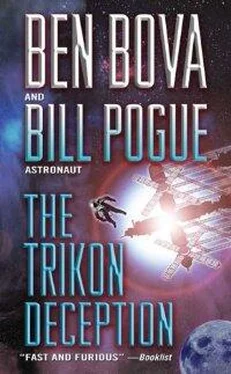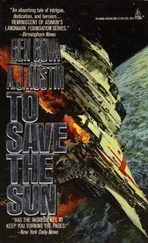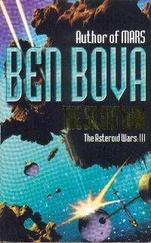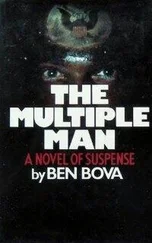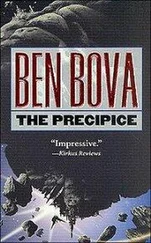The Trikon Deception
by Ben Bova and Bill Pogue
Permission to quote from the Science magazine issue of 28 September 1990 (vol. 249, p. 1503) was graciously given by the American Association for the Advancement of Science and by the author of the article, Leslie Roberts.
The lyrics quoted are from “Space Oddity,” words and music by David Bowie, copyright © 1969 by Westminster Music Ltd. London; TRO-Essex Music International Inc., New York, owns all publication rights for the USA and Canada. Used by permission.
“Ashes to Ashes,” by David Bowie, permission granted by Isolar, New York.
“Rocket Man,” by Elton John and Bernie Taupin, copyright © 1972 Songs of PolyGram International, Inc.
Dimensions aboard Trikon Station are frequently expressed in the metric system. For those not familiar with this European system of measurement: One millimeter is about twice the width of the lead in a mechanical pencil. One centimeter is roughly the thickness of a piece of sliced bread. One meter is about three inches longer than a yard. One kilometer is almost two-thirds of a mile. One kilogram equals 2.205 pounds.
4 SEPTEMBER 1998
TRIKON STATION
To the human eye, space is serene. From three hundred miles above its surface, our Earth appears as a vast, smoothly curved panorama of deep blue oceans and brown wrinkled landmasses decked with parades of gleaming white clouds, ever changing, eternally beckoning. Our world shines with warmth, with beauty, with life.
Floating in the emptiness of space three hundred miles above the luminous curving glory of Earth is a glittering jewel, a diamond set against the infinite darkness of the cold void.
From a distance, hanging against that black infinity, it seems delicate, fragile, a child’s toy construction of gossamer and dreams. It is not until you approach that you realize how large it really is.
Nearly three football fields across, its skeleton is a giant diamond of gleaming alloy girders. Ten sparkling white aluminum cylinders form a raft fixed to its central truss; three of them bear the painted flags of nations: on one cylinder are the twenty-two flags of United Europe; on another is the rising sun of Japan; a third displays the Stars and Stripes of the United States and the Maple Leaf emblem of Canada.
At two corners of the huge diamond are attached two bulbous, blimp-like structures, burnt orange in color and far larger than the white cylinders. Once they were external tanks for space shuttles; now they are extensions of this island in space, moored to the diamond-shaped structure like giant balloons.
The gently tapering nose of one of the ETs points directly forward, the oilier directly aft, us the diamond knifes through the calm emptiness of orbital space. The trailing ET hears the curious circle-and-arrow symbol of the planet Mars.
Robots slide back and forth across the station’s main truss, silent in the airless vacuum, their metal wheels clasping the special guide rails, their spindly arms ending in gripping pincers strong enough to hold hardware that would weigh tons back on Earth. From the topmost corner of the diamond, bristling batteries of instruments aim outward at the stars while others, at the nadir corner, peer down at the dazzling blue sphere of Earth with its white swirls of clouds. On the station’s trailing edge, broad wings of deep-violet solar panels drink in sunlight while smaller, darker companions radiate away the heat generated within the station.
For there are men and women living and working at this outpost in space. This is Trikon Station, the first industrial research laboratory to be built in orbit.
Trikon.
To the human eye, space should be serene. Trikon station floated in its orbit on the sunlit side of the Earth, passing across the radiantly intense blue of the wide Pacific, adorned with clouds of brilliant, purest white.
The station shuddered. Like a giant sail suddenly caught in a crosswind. Like a man startled by danger.
Alarms screeched in every laboratory and living module, Klaxons hooted along the lengths of its passageways, and a computer-synthesized woman’s voice called from every intercom speaker in the station with maddening mechanical calm:
“Emergency. Emergency. Major malfunction. All personnel to CERV stations. All personnel to CERV stations. Prepare to abandon the station.”
No one cared. No one heeded the alarms. No one moved toward the Crew Emergency Reentry Vehicles.
From the astronomical observatory at the uppermost corner of Trikon Station two space-suited figures emerged, one of them encased in the “armchair” rig of a manned maneuvering unit, MMU.
Dan Tighe, commander of Trikon Station, fought back murderous fury and a terrible fear that clawed at his chest as he watched the space station begin to wobble and sway. Through the heavily tinted visor of his helmet he saw the bulbous burnt-orange structure of the Mars module detach itself from the station and begin to drift away, like a rudderless ship caught by an evil tide. The broad wings of the solar panels were swaying, undulating visibly. Dan knew they would break up within minutes.
We’re all going to die, said a voice inside his head. We’re going to die and it’s my fault. All my own goddamned stupid fault.
15 AUGUST 1998
TRIKON STATION
Names are important. When we hammered together this consortium of major industrial corporations I insisted upon a name that would reflect its spirit of international cooperation, a name that would not offend any of the sensitive egos among the various boards of directors, or in the governments to whom they paid taxes. The corporations were based in Europe, North America, and Japan. Three continents: Trikon.
The original spelling proposed was Tricon; however, my public relations consultants suggested that this might cause confusion over the hard or soft pronunciation of the letter c. The letter k connotes strength and provides an echo of classical Greece.
So they said.
—From the diary of Fabio Bianco, CEO, Trikon International
The station had been in operation for more than a year on the day when the trouble began.
David Nutt still encountered that moment of vertigo, that feeling that his insides were adrift and he was falling into a strange pastel-colored abyss. Everything was shifting, swirling like a kaleidoscope.
Clutching at the metal edge of the entry hatch, Dave took a deep breath and lined himself up with the strip of black tape stuck onto the bottom of its lip.
“This side down, stupid,” he muttered to himself.
The pastels tumbled into perspective. A long cylinder with a pale blue-floor and yellow ceiling. Silver and white equipment in racks along the walls. Ovens, centrifuge, microscopes all where they should be, and right-side-up. But it didn’t help that the damned technician was floating almost on his head at the far end of the lab.
The American scientific laboratory module had been nicknamed The Bakery by an earlier rotation of researchers. The pastel colors were the brainchildren of a team of psychologists who had never left the ground. Nutt was grateful for their help. After six months aboard Trikon Station, he still had trouble orienting himself whenever he moved from one module to another. In the microgravity world of the space station, with everything weightless, he had trouble telling up from down without help. If he pulled himself through the hatch at any angle except true vertical The Bakery became a distorted alien world and his guts would start churning. Nutt was a confirmed “flatlander.” He felt queasy unless he had his feet on a solid floor, even in the almost-zero gravity of the space station.
Читать дальше
